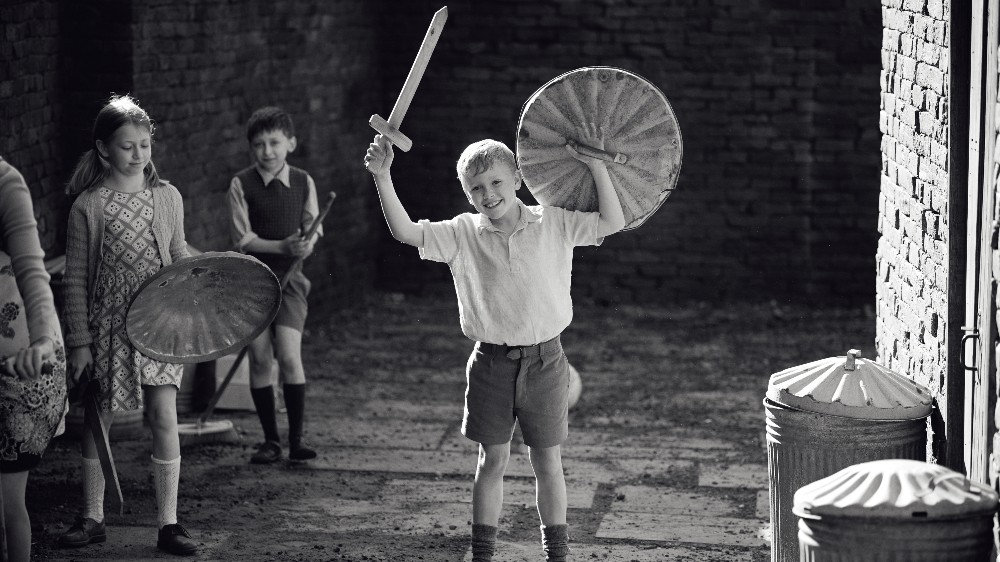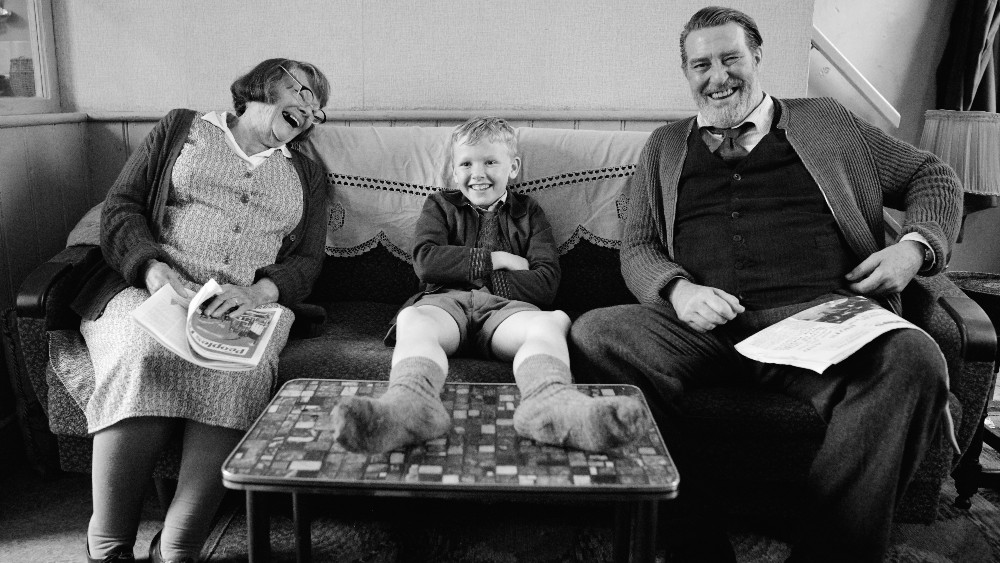
Haris Zambarloukos never set out to become a cinematographer, because he wanted to study art and painting. Everything changed when he made his way to London for college and started studying film. Now well established in Hollywood, Zambarloukos has worked with director Kenneth Branagh on a number of films, including his latest effort, Belfast, which has already earned Zambarloukos a Hamilton Behind the Camera Award for Cinematography as well as a handful of other nominations, including one from the Critics Choice Association.
Belfast stars Jamie Dornan, Caitríona Balfe, Judi Dench, Ciarán Hinds, and newcomer Jude Hill, and it’s a very personal story for Branagh, as it’s a semi-autobiographical take on Branagh’s life at the start of The Troubles in the late ’60s — a story of love, laughter, and loss set against a vibrant backdrop of music and social tumult.
Zambarloukos recently spoke with Below the Line about what went into finding the “Hollywood black-and-white” look that Branagh was searching for, and he also discusses the differences between working on a modestly-budgeted passion project like Belfast and big-budget studio films like Thor and Cinderella.
The cinematographer also explained how the pandemic affected his creative process before taking us behind the scenes of the “Everlasting Love” sequence, which is one of the highlights of the film.
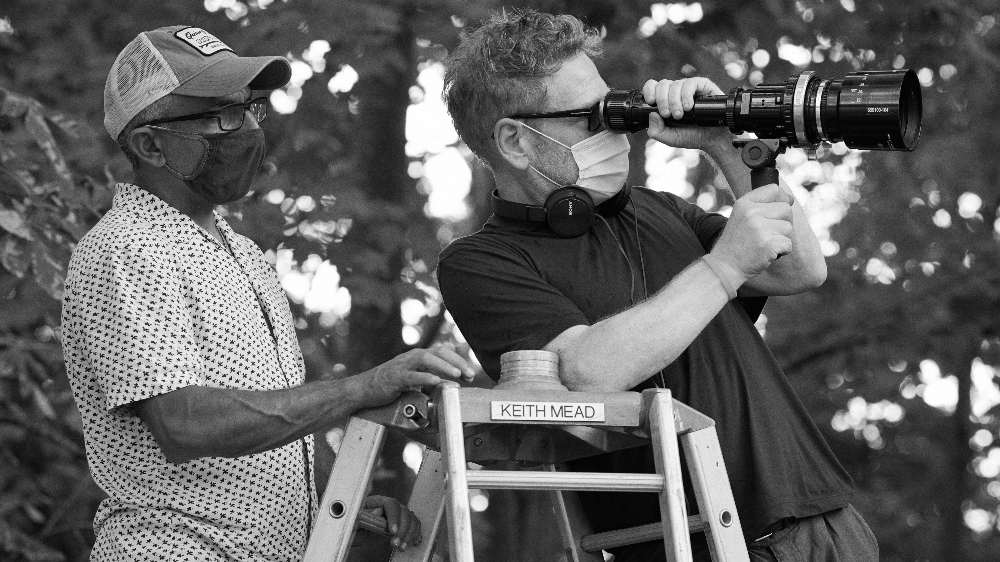
Below the Line: How did you first become interested in being a cinematographer?
Haris Zambarloukos: I didn’t really have an interest in cinema as a child. I grew up on a small island in the Mediterranean called Cyprus. We don’t really have a great traditional cinema there. I really wanted to study art and painting. My parents were generous and gracious enough to let me study art in London. This is the way the English education system in undergraduate arts is — you try a little bit of everything. You try some theatres, paintings, sculptures, and cinema.
I discovered cinema in my first year at St. Martin School of Art. I’d never really thought of film as a fine art — I’d always seen it as entertainment. My childhood in my teenage years were entertaining films of the ‘80s from Back to the Future to The Blues Brothers, for example. As soon as I saw that you could make films as fine art, I quickly switched, and I did a degree in film. I was the only one that really wanted to shoot films. Most of my classmates wanted to be directors. I think it’s because I really felt that it was the application of aesthetics and painting in filmmaking and storytelling, and that’s what drew me.
BTL: You’ve worked with Kenneth Branagh on a number of films now. Was working on Belfast a no-brainer decision?
Zambarloukos: In terms of whether to do it or not? Yes. I don’t need to read the script. If Ken sends me a script, I’d like to do it. I trust his judgment. This is the eighth film we’ve done together, and I enjoy the process of making films with Ken so much that it is never with Ken a question of whether the material is appropriate for me. I am glad to make a film with him at any time.
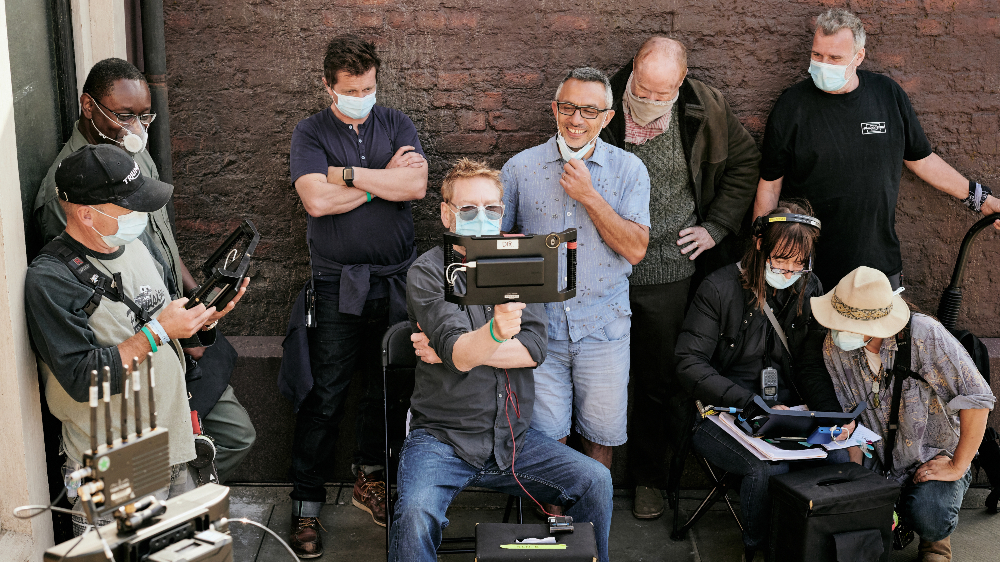
BTL: With numerous projects together, how has the shorthand improved between the two of you?
Zambarloukos: The shorthand has improved, but I also believe that we’ve had the opportunity to develop a very, very clear kind of methodology of shooting that we both feel keeps the intensity and lucidity of the emotion in the story at a certain level that I think we just improve on it. It’s not the same when you make a film for the first time as a director. Not that that’s a problem, and I’ve done that many times. There was always a first time that we worked with Ken on something. Personally, I have enjoyed the ongoing pursuit of an effective way of making films.
BTL: When it comes to working with Kenneth, is there any difference between studio films like Thor or Cinderella and a passion project like Belfast?
Zambarloukos: There always is. Not from our point, I believe, in terms of what you put into a film. I believe we’ve always just jumped onto a project with as much passion regardless. If you’ve decided to make the film, you have a responsibility to make that film in the absolute utmost best way you can.
What I find is different especially with a film like Belfast is we can make decisions really quickly for the greater good. We have been really fortunate on our studio films where we — I do believe we made Cinderella exactly the way we wanted to make it. I would say the same for Orient Express and Death on the Nile. We had extreme support on all our films, but there was something about Belfast that was really special. I think that was a combination of things…
It was a passion project at the end of lockdown. We all hadn’t really worked or had any social contact for six months, and this is just a release. It was such a beautiful, spectacular script to work on that that kind of a social release and relief that you get — I don’t know if you remember at the end of lockdown –but if you channeled all of that energy into making a film about family and love and the joyful participation in the sorrows of life, something was always going to come out of that that was at least special to us.
BTL: What camera and lens did you use for the film?
Zambarloukos: We used an Alexa Mini LF and combination, which is a medium format camera. The sensor is the size of a traditional VistaVision digital sensor. The lenses were a combination of System 65 lenses and Sphero lenses. They are 65mm large format lenses. The System 65 made by Panavision was made around the early ’80s and the Spheros were made probably a couple of decades earlier than that. The Spheros would have been used on some of the David Lean films and the System 65 on films like Hamlet that Ken did. They are exactly the same lenses down to the serial number to what we used on Death on the Nile and Murder on the Orient Express.
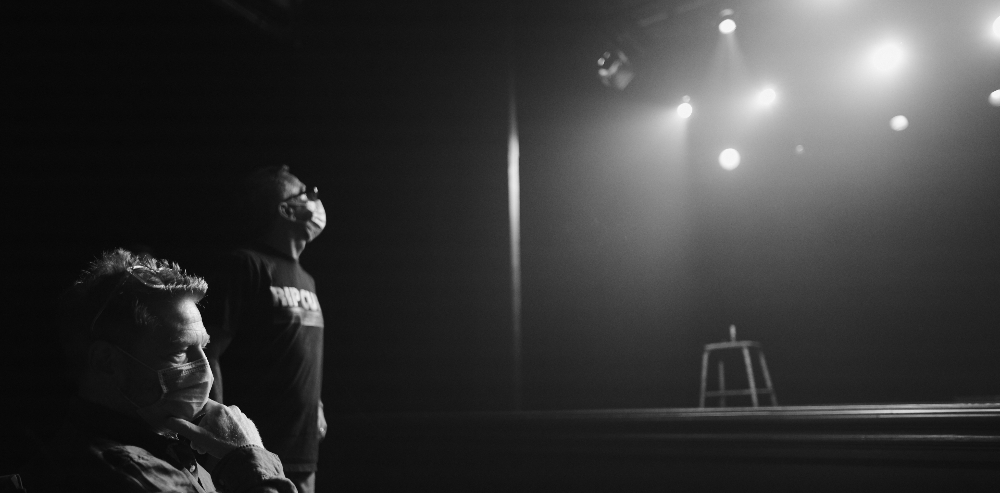
BTL: It’s my understanding that Kenneth Branagh wanted what’s called “Hollywood black-and-white.” Can you talk about the process of finding the film’s look?
Zambarloukos: We ended up on a look that was quite contrasty with really deep blacks and bright highlights, but we didn’t get there immediately. Our initial thoughts were to go for a softer palette. I basically grade — we do kind of what are known as French hours, with a 20-minute lunch break and a 10-hour day. During lunch, I have my lunch and sit with my colorist, my DI, Jo Barker. I view the previous day’s rushes and some of the morning’s rushes and I give my first grade.
My initial thoughts that were kind of obviously decided upon with Ken was that we would go for a slightly softer palette. But as we progressed, it definitely increased in contrast and in that separation between the blackest black and the whitest white. We wanted to bring in as much of a range of grays and tones as we possibly could. By the time we got to the final DI, we really took that a step further.
I think it’s always better that you discover something a little more gently along the way. That was certainly our instinct and something that we’ve always used on previous films. I think we went into [this] leaving ourselves a few windows open to explore and see where the story took us. It took us down this route very clearly, but again, we let the story take us there rather than force it from the beginning.
BTL: Was there a scene that you found challenging from a cinematography perspective?
Zambarloukos: Well, it was all challenging in a way. The biggest challenge for us all, I think, was that we shot in August last year, [when] there were so many COVID protocols. We spent so much time thinking about those and working under those circumstances. That was the new thing for us. I would say, in particular with the COVID protocols and shooting in a certain way, the riot scenes presented an extra challenge because we wanted to make them immersive and have a lot of action and movement, especially with those still in other parts of the film. Those proved challenging, but again, rewarding in the end. I also think that we let the limitation become something that we would embrace.
I’ll give you an example. We certainly decided that we would shoot with available light for most of this film, and it pretty much is lit with either practical [lighting] in the home or available light outside. There are a few occurrences where we couldn’t do this: the poor man’s process of the bus and the interior cinema. But everything else was pretty much either practical lighting or available lighting. The available lighting changed dramatically all the time. We’d have four scenes in a day often and we’d have four scenes within a shot, so we embraced that.
Many of the shots are composed in a way that you would see the effect of the change of light. We thought that rather than make a very catchy film, we would allow some space around our actors and in our framing to allow the weather to play a part. And in the end, we felt that gave a real serial quality to some of the shots. That would have, in normal circumstances, been a challenge — something that you’d want to ultimately control and light yourself with artificial lighting. But we just embraced natural light and let that play a part in our story.
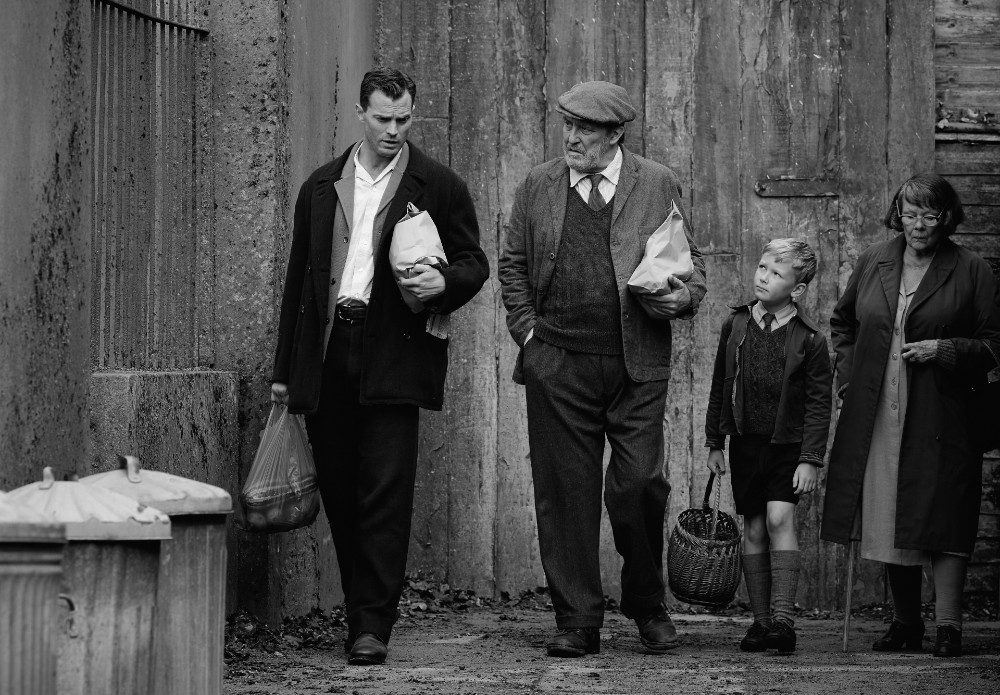
BTL: In terms of the pandemic, how did it change up your process in terms of setting up shots?
Zambarloukos: It made a difference in our blocking, obviously. We wanted to keep a distance from our actors and we also wanted our actors to keep a distance between themselves and [which way] they faced. For example, Dame Judi and Ciarán were often placed kind of facing a window and apart from each other. Again, this limitation or this concern became something that we thought, well, how do we use this and block the scene [so that it] makes sense and actually, it could add something?
Our observations of Belfast, certainly from Ken’s point of view, personally, and for mine as a visitor when we went there, was that people really love to watch the world go by there. There were a lot of open windows, there were lots of chairs out on the street, and people went about their daily lives just watching their streets. We turned that into a kind of methodology for shooting regarding COVID, because this is obviously pre-vaccination and again, turned it into a style that suited the film.
BTL: You’re no stranger to musicals, having worked as the DP for Mamma Mia. Can you discuss working on the “Everlasting Love” sequence in Belfast?
Zambarloukos: That just felt so natural. We’ve done quite a bit of musical kind of scenes with Ken — the ballroom sequences in Cinderella, and he’s no stranger to it himself. He choreographed that with the actors and a choreographer, and then, it was quite simple. We played the song, did a rehearsal. I had an idea of where we would place the cameras and made a shot list and just worked that way. I find shooting musical sequences no different [than] action sequences. You have a shot list and usually a storyboard. You’ve got certain things you want to cover. As long as you’ve done that, in the first instance and rather rapidly, you then get a chance to let happy accidents happen, perhaps reaction.
In terms of a musical, I think a certain amount of theatricality in the lighting helps. In this instance, it was, again, practical lighting. We set up the whole thing different — it wasn’t a musical — with basic theatrical lighting, and that’s how we lit the scene, but then we composed to let them either flare the lens or add a slight bit more panache to a scene than we would have done if we were in grandma’s kitchen, for example.
Those things, you can set it up for that, but then you have to find them while you’re shooting. I find it kind of rewarding and easy to do things like that. It felt quite effortless. We set up the room and the choreography was great and [it was] such a great musical performance that it made it quite easy and delightful for us.
Belfast is now playing in theaters and available to rent on demand.
